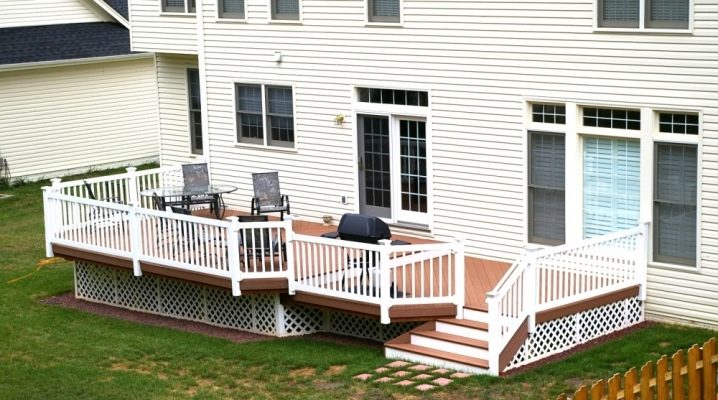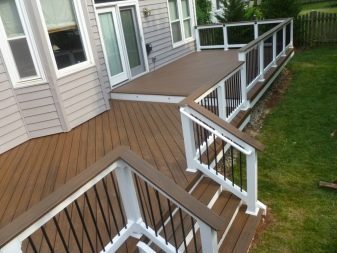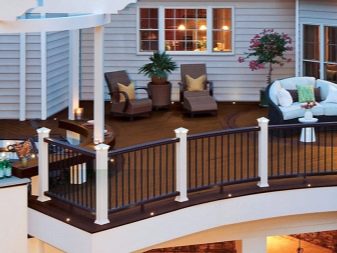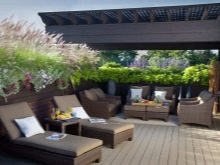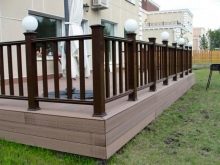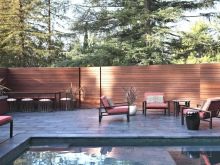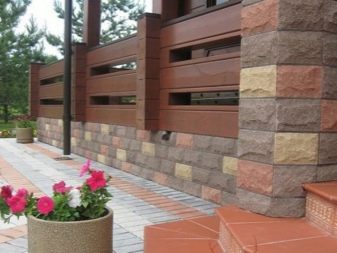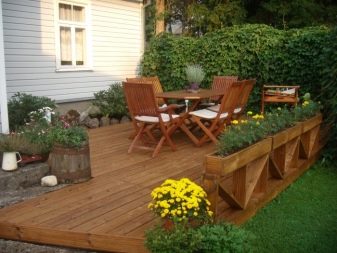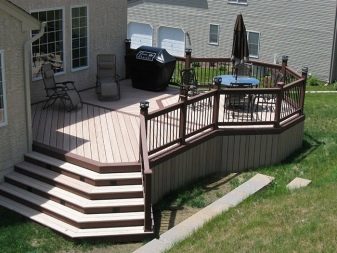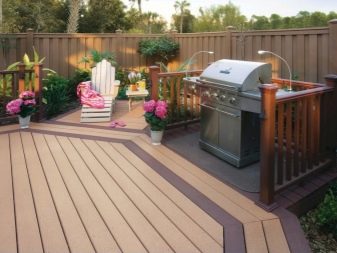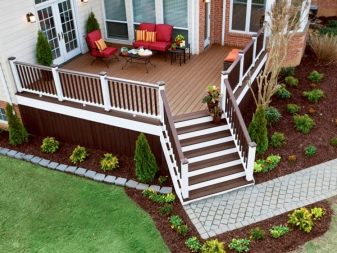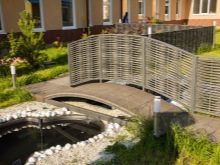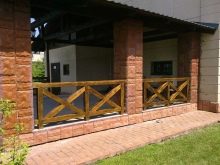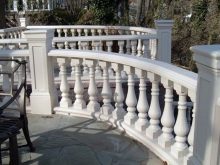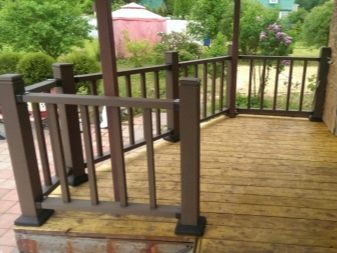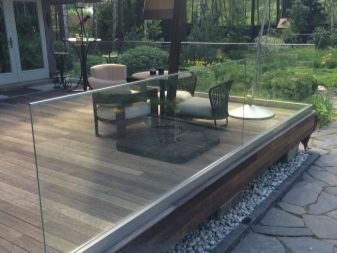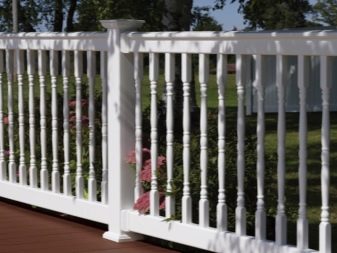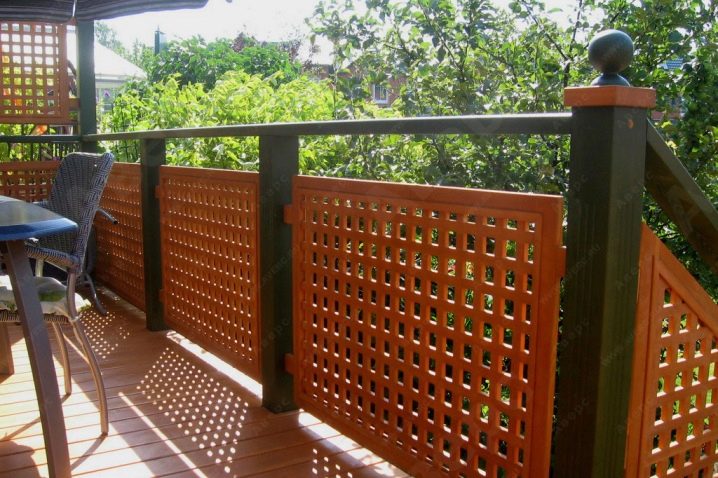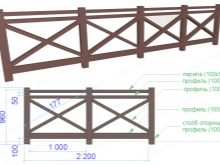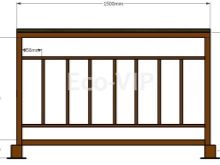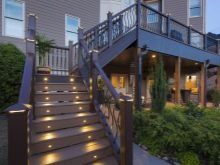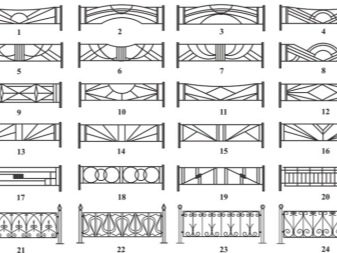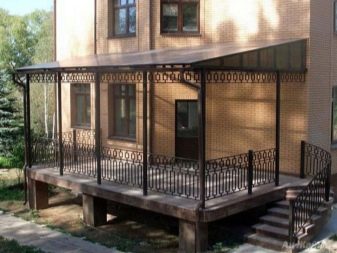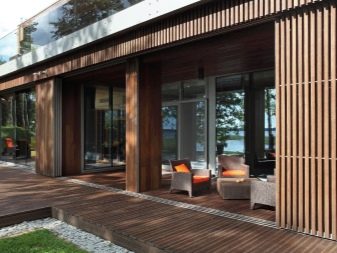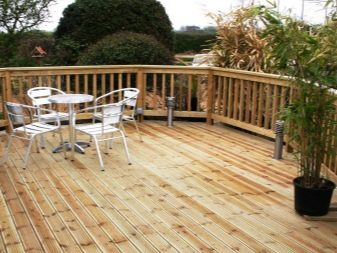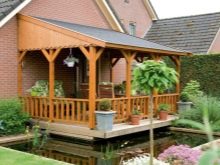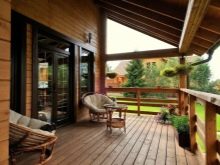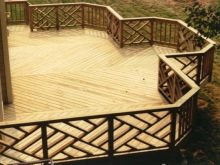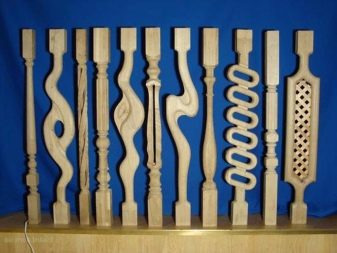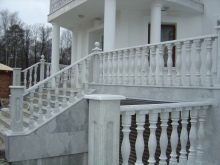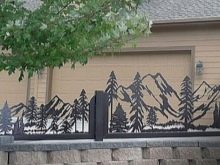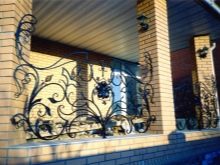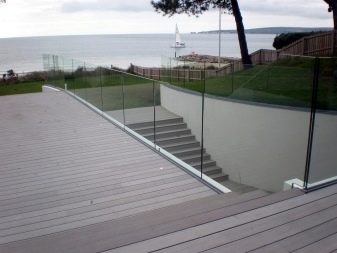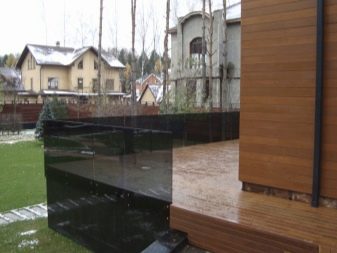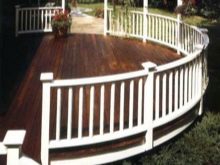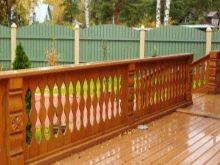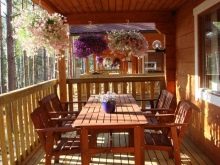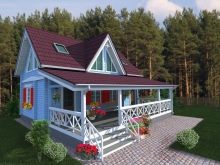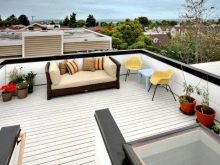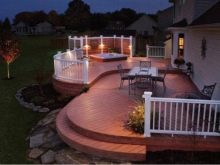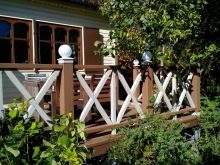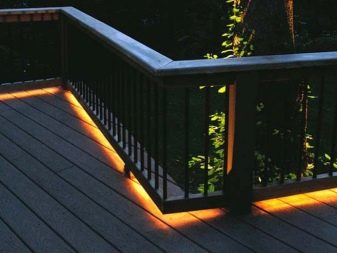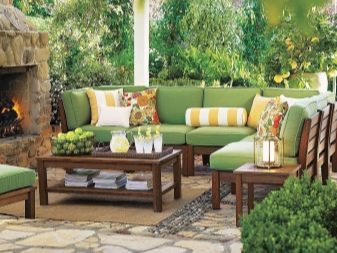Terrace Fences: Types of Materials and Design Examples
If a residential house or any other building has a terrace, it is necessary to consider the feasibility of installing a fence when drafting a project. Pre-thoughtful selection of the type, material and method of installation - a pledge of the functionality of the fence.
Special features
Terrace fencing consists of two structural elements: the frame and its filling. How they will look, first of all depends on the functions they perform.
- The protective function is to resist natural phenomena (as a result - drafts, dust) or prevent animals from entering (important when the house is located in a forest belt and there are enclosures in the adjacent territory, buildings for cattle).
- The decorative function is important when the fence is one of the decorations not only at home, but also of the land that make up a harmonious ensemble.
- Dividing function: even the most symbolic version of the terrace fence can act as a kind of boundary, which is necessary for psychological comfort, restriction of access for unauthorized persons or movement of children (especially small ones).
Accordingly, the fence can be permanent or temporary (they are installed during any events or at the beginning of the summer season, if we are talking about a summer cottage). Their difference lies in the method of fastening to the terrace floor and reliability.
In appearance, fences are divided into:
- open (consisting of longitudinal and transverse parts - columns, slats, located at a certain distance between them);
- closed (when the space between the supports and racks is filled completely with sheet materials or rack, fixed close to each other).
In many ways, the choice of fencing depends on the location of the terrace, the way it is used and the appearance of the house. The higher it is, the more stringent requirements must be placed on the enclosing structure: it must be safe, durable and reliable.If children are constantly playing here or a dinner table is set, it is better to give preference to more practical options.
In addition, do not forget that if the terrace is located along the front of the building and is the face of the building, you need to keep a close eye on its fence, it should be easy to clean and not require large repair costs. If initially there was no fence, but subsequently there was a need for its installation, you should not choose a model, the installation of which will require large expenditures and a significant restructuring.
Combination of materials
Terraced fencing can be classified not only by appearance, but also by production. For their manufacture various materials are used.
- Tree. The main requirement for it is density (for this, such species as oak, beech, birch, pine are taken) and its resistance to weather conditions (in order to increase this indicator it is necessary to saturate it with a water-repellent compound). In addition to natural beauty, wood can be easily treated and can be covered with enamels and varnishes. Instead of wood, bamboo, wicker and other materials are often used.of which you can make a wicker fence.
- Natural and artificial stoneIt can withstand heavy loads and is durable. Of the minuses of the stone can be noted a lot of weight, with which the difficulty of transportation and installation. And the basis for such a structure should be appropriate strength. A common option is to build a fence as a continuation of the foundation.
- Metal not inferior in strength to the above materials. In the processed version can satisfy almost any taste. Polished or matte details can be metallic hues or painted. The space for imagination opens up the possibility of giving any form and use of forged elements.
- WPC (wood-polymer composite) - it is cheaper to replace wood products, it can completely imitate it. Resistant to all weather conditions due to chemical additives. Popularity due to affordability.
- Plastic - more fragile material, does not maintain loadings, for its application on the street it is possible to use only its types,which are not subject to ultraviolet and temperature fluctuations (polycarbonate and the like). But it has a greater choice of color palette and relief, easily transported and fixed.
- Glass less commonly used for upper terraces. Its alternative is transparent and translucent plastic.
The fence is very rarely only plastic, glass, wood or metal. To reduce the cost, facilitate the construction and speed up the installation process, the supports use more durable materials, while the distance between them is filled with less durable ones. For reasons of strength, proceed when choosing the upper part (rail). Another selection criterion is the material processing capabilities. To make the structure more interesting, it is possible to stretch the metal mesh or wood grate between the brick or metal posts, fasten the forged composition, insert plastic slats or beams of intricate shape.
Dimensions
The parameters of all construction sites are determined by the relevant rules and regulations. Any object above 60 cm should have barriers.If the difference between the ground and the terrace or its levels is more than a meter, the fence should not be lower than 90 cm, since such a place can be considered potentially dangerous. If we consider a platform located on the second floor level or on the roof of a building (at a distance of about 2 meters from the ground), the height of the enclosing structures should increase accordingly and be no less than 110 cm. The width between the supports should be about 120 cm. For ductile materials, this distance may be shorter. Of course, compliance with this requirement may break the symmetry. In this case, it is better to divide the distance into smaller equal segments.
Special requirements are placed on safety. 1 linear meter of construction must withstand a load of about 300 kilograms. Traumatic materials are not permissible or should be replaced (for example, tempered glass is more durable, and it is more difficult to injure yourself when destroyed). Double attachments to posts and other supporting objects are welcome. For elevated terraces, in accordance with the standard, only metal should be used. Filling the frame should be continuous (priority is sheet materials) or at least consist of both longitudinal and transverse elements.The longitudinal-transverse arrangement prevents the falling of children or animals. In addition, so that the child could not get stuck, the distance between the elements must be not less than 10 cm. Yes, and the crossbar must be located in such a way that it is impossible to climb over them.
Of course, if you can get off the terrace, taking only one step, you can fence it in any suitable way. But in the event that a fall from it is dangerous, it is better to take care of the observance of all norms, since they prevent the creation of situations in which you and your loved ones may suffer.
Design
Do not think that the options for fencing for the terrace a bit. Their diversity mainly depends on the decor of the main elements and their harmonious combination.
Filling the space in the frame of an open fence can be:
- vertical (striking examples are balusters, fixed between the base and the railing);
- horizontal (when the slats are located between the columns parallel to the floor, where the top can be a support for the hands);
- cross (the details of the filling intersect, forming a pattern, strengthen or reduce the possibility of penetration between them);
- combined (when the filling between the columns alternates depending on the artistic intent or design features of the terrace).
The most pronounced part of the fence is the space between the base of the fence and the handrail. There are several types of balusters.
They can be:
- flat or bulk;
- smooth;
- relief (with openwork or deaf carving, chiseled, figured).
To make the fence more decorative value to add a balustrade can thumbs, which can be replaced with columns or even columns of different widths and shapes. An alternative to balusters are shields, panels, longitudinal strips and other decorative elements that fill the distance between the posts. From suitable materials, you can create abstract compositions, panels with images of animate and inanimate nature. Yes, and the pillars themselves may not be, if you make a low fence made of brick or stone - in this case, the support for the roof can be mounted directly into it.
The concise version in the form of glass or plastic is more modern. Of course, a transparent, weightless fence will not in any way affect the appearance of the building, especially if it has no railing or pronounced supports.But the color, and even with a glossy surface in any case will not go unnoticed. A spectacular addition will be shiny chrome parts.
The fence can repeat the outline of the terrace or have any other configuration.
- Straightforward options - the most familiar. Usually, the enclosed site has a regular shape in the form of one of the geometric figures, with walls on one or both sides, and the fence repeats its contour.
- Radial models are made in the shape of a circle or semicircle (the platform is completely or some part of it). But even the usual rectangular terrace can vary the wave barrier.
- Curvilinear varinaty: modern materials and methods of their processing allow building structures of almost any shape in accordance with the designer's plan.
Particular attention should be paid if the stairs go to the terrace. For a more comfortable movement on them, comfortable arm supports (handrails) are required. It is better if the top of the fence is trimmed with handrails, just like at the railing, except that in the first case they may already be.
Beautiful examples
So that all the details of the house and its surroundings are in harmony with each other, it is important to adhere to the same style when choosing them. For a country house, this may be the appropriate direction, reminiscent of a ranch, village house or a medieval mansion. In the city, the terrace can be located on the roof, above the garage or underground parking. This saves space, but the fence in this case should be more durable and preferably solid.
A special place is occupied by multi-level terraces. Bind together all levels can undulating barrier. It looks interesting cascade of fences of different heights. With the help of unequal high fences it is possible to allocate on the veranda a place for rest, eating, conducting water procedures. In these places to create the appropriate atmosphere, you can more densely place the material of a different color or texture.
A win-win is decorating the fence with lamps. They can be fixed on posts or supports. LED strip can be laid along the entire length and hide it in the base or under the handrails. In some cases, plants, furniture, curtains, textiles and other objects can be used as a temporary option for a hedge.which your imagination will indicate to you.
Review the wooden terrace in the video below.
